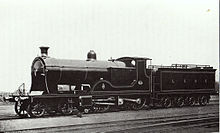4-2-2-0
This article relies largely or entirely on a single source. (February 2015) |
Under the Whyte notation for the classification of steam locomotives, 4-2-2-0 represents the wheel arrangement of four leading wheels on two axles, four independently driven driving wheels on two axles, and no trailing wheels. The arrangement became known as double single.[1][2]
Usage

This very unusual wheel arrangement was first used 1893 by Frederick Charles Winby for the locomotive James Toleman, built by
Hawthorn Leslie & Company. It was exhibited at the World's Columbian Exposition in Chicago and then delivered to the Milwaukee Road.[3]
Between 1897 and 1901
coupling rods enabled the driving wheels to be more widely spaced than on a 4-4-0 locomotive and permitted the inclusion of a larger firebox[4]
Seven locomotives of the type were built which performed adequately, but also displayed disadvantages[example needed] over a 4-4-0 and so the type was not perpetuated.
References
- ^ L&SWR Drummond Passenger and Mixed Traffic Locomotive Classes. Pen and Sward Transport. 2020. p. 63.
- ^ "The Evolution of Compound Locomotives". 1935. Retrieved 2023-07-08.
- ^ "James Toleman" (in German). Retrieved 2022-05-11.
- ^ Bradley, D.L. (1967). Locomotives of the London and South Western Railway, Part 2. Railway Correspondence and Travel Society. p. 77.
